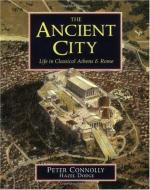
|
| Name: _________________________ | Period: ___________________ |
This test consists of 15 multiple choice questions and 5 short answer questions.
Multiple Choice Questions
1. Although no pictures of these have been found, we know these existed in fifth century Athens.
(a) Canons.
(b) Ships.
(c) Cranes.
(d) Engines.
2. The final day of the festival is devoted to this.
(a) Sacrifice.
(b) A feast.
(c) Races.
(d) Prizes.
3. What is the only crime in Athens for which a woman can divorce her husband?
(a) Murder.
(b) Adultery.
(c) Continued abuse.
(d) Theft.
4. These are used to channel water to the city of Athens.
(a) Clay pipes.
(b) Glass pipes.
(c) Metal pipes.
(d) Gold ditches.
5. This is the amount sculptors are paid per sculpture for working on the sculptures from the Erechtheum.
(a) 100 drachmae.
(b) 6000 drachmae.
(c) 1000 drachmae.
(d) 60 drachmae.
6. The Patron God of Athens is _________.
(a) Zeus.
(b) Ares.
(c) Athena.
(d) Hades.
7. The Panathenaic Games are only for these people.
(a) Athenians.
(b) All Greeks.
(c) Slaves.
(d) Women.
8. These houses are cut into the hillside.
(a) Semi-detached houses.
(b) Block houses.
(c) Workshop houses.
(d) Hill houses.
9. This many main Gods are worshiped in Athens.
(a) Twelve.
(b) Twenty.
(c) Two.
(d) Eighty.
10. This house displays an early example of the Masonry style, with plaster molded into rectangles in different colors.
(a) The House of Many Designs.
(b) The House of Rainbows.
(c) The House of Many Colors.
(d) The House of Many Shapes.
11. This is the best known storehouse for the equipment of the large Athenian navy.
(a) Arsenal of Phaleron.
(b) Arsenal of Athens.
(c) Arsenal of Delphi.
(d) Arsenal of Philon.
12. The women of Athens are primarily expected to do this.
(a) Stay home and care for the family.
(b) Go to work, and support the family.
(c) Attend community theater events, and be highly social.
(d) Attend functions with her husband.
13. What do many Athenians do to unwanted children?
(a) Murder them.
(b) Give them up for adoption.
(c) Abort them.
(d) Expose them to the elements to die.
14. Ancient walls around the city are believed to have been built in ____.
(a) 5th century BC.
(b) 8th century AD.
(c) 6th century BC.
(d) Both 5th and 6th century BC.
15. These events have a high risk of injury or death.
(a) Boxing.
(b) Track events.
(c) Wrestling.
(d) Chariot races.
Short Answer Questions
1. At Olympia, women who watch the games are ___________________.
2. This person, the designer of the building, puts together a team of sculptors to create the sculptures outside the Parthenon.
3. How many members are there in the boule?
4. Marriage in Athens is _______.
5. Hades is the god of this.
|
This section contains 382 words (approx. 2 pages at 300 words per page) |

|




